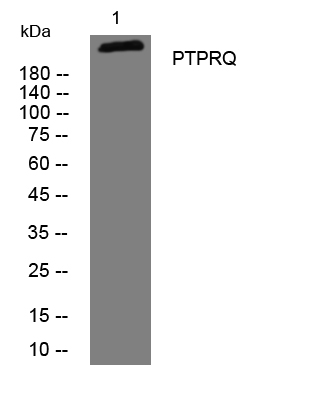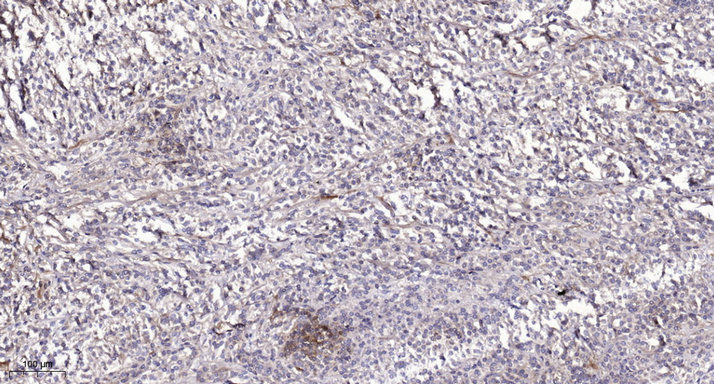PTPRQ Rabbit Polyclonal Antibody
PTPRQ Rabbit Polyclonal Antibody
- 产品详情
- 实验流程
- 背景知识
Application
| WB, IHC |
|---|---|
| Primary Accession | Q9UMZ3 |
| Reactivity | Rat, Human, Mouse |
| Host | Polyclonal, Rabbit,IgG |
| Clonality | Polyclonal |
| Calculated MW | 260924 Da |
| Other Names | Phosphatidylinositol phosphatase PTPRQ, 3.1.3.67, 3.1.3.86, 3.1.3.95, Receptor-type tyrosine-protein phosphatase Q, PTP-RQ, R-PTP-Q, PTPRQ |
|---|---|
| Dilution | WB~~1:1000 IHC~~1:100~500 |
| Storage Conditions | -20℃ |
| Name | PTPRQ |
|---|---|
| Function | Dephosphorylates phosphatidylinositol phosphates, such as phosphatidylinositol 3,4,5-trisphosphate (PIP3) and phosphatidylinositol 3,5-diphosphates, with preference for PIP3 (PubMed:23897475). Phosphate can be hydrolyzed from the D3 and D5 positions in the inositol ring (PubMed:23897475). Has low tyrosine- protein phosphatase activity in vitro; however, the relevance of such activity in vivo is unclear (By similarity). Plays an important role in adipogenesis of mesenchymal stem cells (MSCs). Regulates the phosphorylation state of AKT1 by regulating the levels of PIP3 in MSCs and preadipocyte cells (PubMed:19351528). Required for hair bundle maturation, a process that enables hair cells to detect and transmit sound and balance signals effectively, therefore affecting auditory function (PubMed:20472657, PubMed:29309402). May act by regulating the level of phosphatidylinositol 4,5-bisphosphate (PIP2) level in the basal region of hair bundles (By similarity). |
| Cellular Location | Cell projection, stereocilium {ECO:0000250|UniProtKB:P0C5E4}. Apical cell membrane; Single-pass type I membrane protein. Basal cell membrane; Single-pass type I membrane protein. Note=Detected at the stereocilium base and at the apical cell membrane in mature hair cells (By similarity). Forms ring-like structures in the stereocilium taper region (By similarity). Detected at the basal cell membrane in fetal kidney podocytes (PubMed:12837292) {ECO:0000250|UniProtKB:P0C5E4, ECO:0000269|PubMed:12837292} |
| Tissue Location | In developing kidney, it localizes to the basal membrane of podocytes, beginning when podocyte progenitors can first be identified in the embryonic kidney (at protein level). Expressed in lung and kidney. |
Research Areas
For Research Use Only. Not For Use In Diagnostic Procedures.
Application Protocols
Provided below are standard protocols that you may find useful for product applications.
BACKGROUND
This locus encodes a member of the type III receptor-like protein-tyrosine phosphatase family. The encoded protein catalyzes the dephosphorylation of phosphotyrosine and phosphatidylinositol and plays roles in cellular proliferation and differentiation. Mutations at this locus have been linked to autosomal recessive deafness. [provided by RefSeq, Mar 2014],
终于等到您。ABCEPTA(百远生物)抗体产品。
点击下方“我要评价 ”按钮提交您的反馈信息,您的反馈和评价是我们最宝贵的财富之一,
我们将在1-3个工作日内处理您的反馈信息。
如有疑问,联系:0512-88856768 tech-china@abcepta.com.























 癌症的基本特征包括细胞增殖、血管生成、迁移、凋亡逃避机制和细胞永生等。找到癌症发生过程中这些通路的关键标记物和对应的抗体用于检测至关重要。
癌症的基本特征包括细胞增殖、血管生成、迁移、凋亡逃避机制和细胞永生等。找到癌症发生过程中这些通路的关键标记物和对应的抗体用于检测至关重要。 为您推荐一个泛素化位点预测神器——泛素化分析工具,可以为您的蛋白的泛素化位点作出预测和评分。
为您推荐一个泛素化位点预测神器——泛素化分析工具,可以为您的蛋白的泛素化位点作出预测和评分。 细胞自噬受体图形绘图工具为你的蛋白的细胞受体结合位点作出预测和评分,识别结合到自噬通路中的蛋白是非常重要的,便于让我们理解自噬在正常生理、病理过程中的作用,如发育、细胞分化、神经退化性疾病、压力条件下、感染和癌症。
细胞自噬受体图形绘图工具为你的蛋白的细胞受体结合位点作出预测和评分,识别结合到自噬通路中的蛋白是非常重要的,便于让我们理解自噬在正常生理、病理过程中的作用,如发育、细胞分化、神经退化性疾病、压力条件下、感染和癌症。







